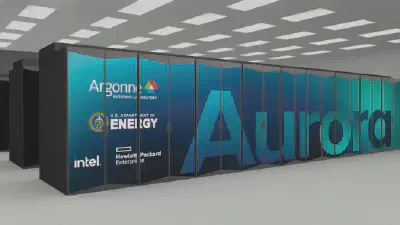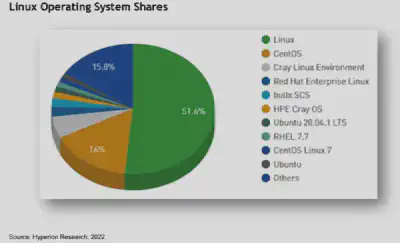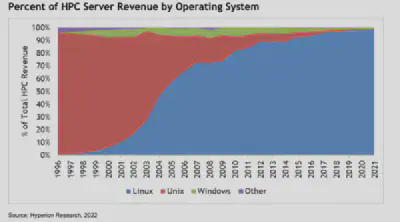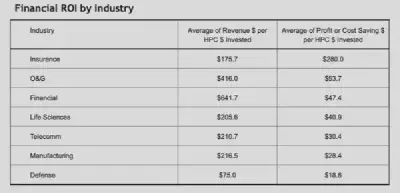Hyperion Study Tracks Rise and Impact of Linux Supercomputers

By John Russell

That supercomputers produce impactful, lasting value is a basic tenet among the HPC community. To make the point more formally, Hyperion Research has issued a new report, The Economic and Societal Benefits of Linux Supercomputers. Inclusion of Linux is fundamental here. The powerful, open source operating system was embraced early by the HPC world and helped spawn a huge HPC application ecosystem that makes these systems so broadly useful.
(Thank you, Linux developer Linus Torvalds and David Bader, distinguished professor, New Jersey Institute of Technology, one of the leaders pushing Linux into early supercomputing.)
“Supercomputers have made cars and planes much safer, more fuel efficient and environmentally friendly. They are crucial aids in discovering and extracting new sources of oil and gas, and for developing alternative energy sources. They have enabled the weather community to create more accurate predictions of severe storms that can devastate lives and property. They are heavily relied on by industries ranging from financial services to medicine and health care, entertainment, consumer products, and more recently by Internet companies. And most recently, supercomputers were instrumental in addressing the COVID-19 pandemic,” asserts the report.
That’s an impressive list. While the subject matter isn’t new, the report is a good reminder and snapshot of the power (and profitability) of HPC writ large. Hyperion briefly traces the history of Linux and the vast application universe it helped spawn, and how when combined in supercomputers, not only do good things happen, but also big things can happen.
Here’s an excerpt from the introduction:
“This special study explores the early history of how Linux supercomputers were developed and the overall returns from supercomputing in both: 1) the economic value from building and supporting supercomputers; and 2) the value from using supercomputers. Additionally, this report presents some interesting examples of how supercomputers provide returns.
“Over $300 billion in revenue has been generated from selling supercomputers. This represents a sizable economic gain, especially since the use of these systems generated research valued at least ten times over the purchase price. While it is difficult to fully measure the value that supercomputers have generated, even looking at just automotives, aircraft, and pharmaceuticals supercomputers have contributed to products valued at more than $100 trillion over the last 25 years. And this doesn’t count the tremendous value to new scientific discoveries in almost all disciplines.”
Based on the consistent high-growth rates of HPC purchases to address some of the most challenging national issues and to increase corporate competitiveness, says the report, the next five years are expected to produce even high revenues.
“Looking just in 2022, the direct economic returns are projected to exceed $16 billion in servers and around $30 billion including the supporting infrastructure. The direct economic returns from selling Linux computers in 2022-2026 are projected to exceed $90 billion in servers and an additional $90 billion for the supporting infrastructure. This results in nearly $200 billion in revenue generated from selling Linux supercomputers over just a five-year period. This represents a sizable amount of economic gain, especially since the use of these Linux systems generates research valued at least ten times over the purchase price,” according to the study.
The study documents Linux’s spectacular rise noting: “A clear step change in multiple developmental facets of the technology, open-source Linux OS-based supercomputers quickly gained popularity between the years of 2002-2010, representing over 90% of the Top500 in that year, and representing 82% of all technical servers in 2010. While it has since become the only OS represented on Top500 list, there [is] a wealth of diversity for those with different requirements or limitations. Needs for specific hardware, application, data, or user types can and are met with one of a plethora of Linux-based operating systems market offerings (as shown in Figure 3). Figure 3 shows (below) that a number of companies have been created to sell and support Linux operating systems.”


The Hyperion report also calls out ROI for use of Linux supercomputers based on average financial impacts by sector for 175 projects. “The average financial ROI was $509.3 dollars in revenues/sales per dollar invested in HPC, and $47.2 dollars in profits or cost savings per dollar invested in HPC. In addition, there were 2,335 new jobs created from these projects,” declares Hyperion.


On balance the report is quick read covering a bit of history and pulling together data points to showcase the rise and impact of supercomputing.
Link to study, https://davidbader.net/publication/2022-hyperionresearch/2022-HyperionResearch.pdf
Feature image: The Aurora exascale supercomputer now being installed at Argonne National Laboratory.
Hyperion Report authors: Earl Joseph (CEO), Melissa Riddle (associate analyst), Tom Sorensen (associate analyst), and Steve Conway (senior advisor)
https://www.hpcwire.com/2022/05/17/hyperion-study-tracks-rise-and-impact-of-linux-supercomputers/